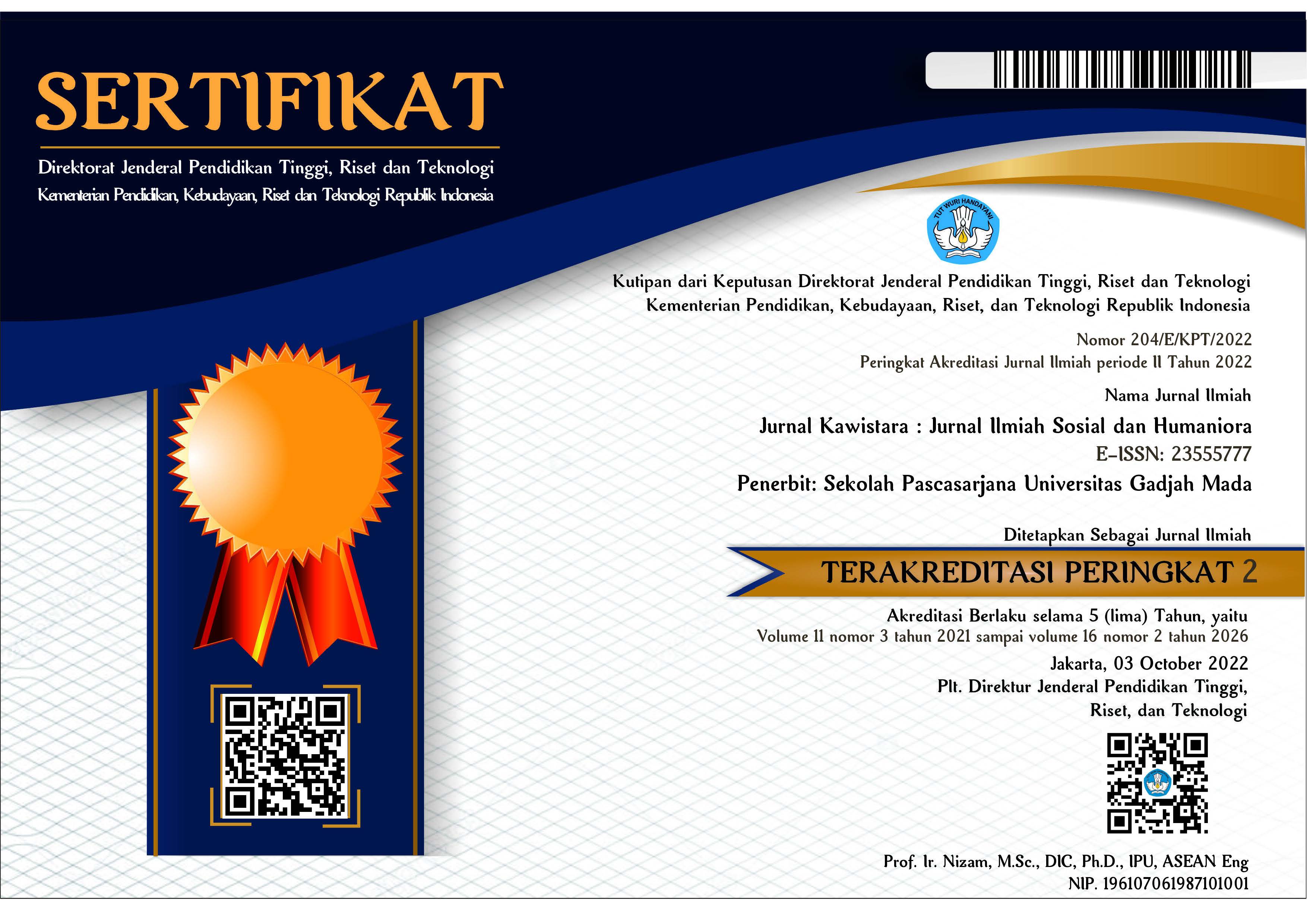Spatial Adaptation of Intellectual Disability Children in Special Needs School’s Dormitory in Yogyakarta
Eko Widodo(1*), Syam Rachma Marcillia(2)
(1) Universitas Gadjah Mada
(2) Departemen Teknik Arsitektur dan Perencanaan Fakultas Teknik UGM
(*) Corresponding Author
Abstract
Various studies have shown the important roles of spatial environment in shaping behavior and cognitive processes. However educational buildings are often not well designed for this specific purpose. This is especially the case with school dormitory for special need schools. The unavailability of school dormitory planning standards has an impact on variations in the building’s diverse physical settings. The daily activities carried out in the dormitory still found the use of one space for several types of activities. This has an impact on the density level, which further requires spatial adaptation that will be implemented by the residents. This study aims to find out spatial adaptation in three different physical settings of special needs school dormitories with the focus of observation being children with intellectual disabilities. The research method is based on a behavior mapping - place centered mapping approach. As the result, this research shows that there are variations in different spatial adaptations in responding to each of the physical setting conditions of the dormitory. The form of spatial adaptation involves changes in the physical setting and behavior, namely adjustment, reaction, and withdrawal. Furthermore, this type of spatial adaptation has different ways in achieving the ideal conditions of activities carried out in the physical setting of the dormitory.
Keywords
Full Text:
PDFReferences
Akbar, E. P. (2012). Pengaruh Seting Ruang dan Lingkungan Terhadap Perilaku Adaptasi Siswa Tuna Daksa di SLBN 1 Bantul Yogyakarta. Tesis, Yogyakarta: Universitas Gadjah Mada.
Amole, D. (2009). Residential satisfaction in students’ housing. Journal of Environmental Psychology 29(1): 76–85. https://doi.org/10.1016/j.jenvp.2008.05.006
Be‘Be, B., Edgü, E., & Yumu‘Taci, D. G. (2016). Differences Of Cultural Effects On The Transformation Of Dorm Spaces. In D. of I. Architecture (Ed.), 5th International Interior Architectural Symposium “Innovative Approaches to Space Design” (p. 1689–1699). Istambul: Mimar Sinan Fine Arts University. https://doi.org/10.1017/CBO9781107415324.004
Bell, P. A., Greene, T. C., Fisher, J. D., & Baum, A. (2001). Environmental Psychology. Fifth Edition. Orlando: Harcourt, Inc.
Berry, J. W. (1976). Human Ecology and Cognitive Style: Comparative Studies in Cultural and Psychological Adaptation. New York: SAGE Publications, Inc.
Berry, J. W. (1980). Cultural Ecology and Individual Behavior. In I. Altman, A. Rapoport, & J. F. Wohlwill (Ed.), Human Behavior and Environment (Volume 4). New York: Plenum Press.
Chiara, J. De, & Callender, J. (1983). Timesaver Standards For Building Types. 2nd ed. New York: McGraw-Hill Book.
Desiningrum, D. R. (2016). Psikologi Anak Berkebutuhan Khusus. Yogyakarta: Psikosain.
Haryadi, & Setiawan, B. (2014). Arsitektur, lingkungan dan perilaku. Yogyakarta: Gadjah Mada University Press.
Hayuningsasi, G. (2015). Hubungan Seting Ruang Luar Dengan Interaksi Sosial Anak Tuna Daksa (SLB N 1 Bantul). Tesis, Yogyakarta: Universitas Gadjah Mada.
Holahan, C. J. (1982). Environmental Psychology. New York: Random House.
Kocaman, G. Y., Sezer, F. S., & Cetinkol, T. (2017). User Satisfaction of Indoor Environmental Quality in Student Dormitories. European Journal of Sustainable Development 6(1): 11–12. https://doi.org/10.14207/ejsd.2017.v6n1p11
Laurens, J. M. (2004). Arsitektur dan Perilaku Manusia. (D. Novita, Ed.). Jakarta: PT Grasindo.
Nisa, K. (2017). Adaptasi Penghuni Pada Asrama Mahasiswa Universitas Gadjah Mada. Skripsi, Yogyakarta: Universitas Gadjah Mada.
PSMA, D. (2018). Sekolah Menengah Atas Berasrama. (D. P. SMA, Ed.). Jakarta: Kemdikbud.
Rahim, Z. A., & Hashim, A. H. (2018). Behavioural Adaptation of Malay Families and Housing Modification of Terrace Houses in Malaysia. Asian Journal of Environment-Behaviour Studies 3(6): 49–57. https://doi.org/10.21834/aje-bs.v3i6.235
Rapoport, A. (1969). House Form and Culture. Englewood Cliffs., N.J.: Prentice Hall, Inc.
Rapoport, A. (2005). Culture, Architecture, and Design. Chicago: Locke Science Publishing Company, Inc.
Sommer, R., & Sommer, B. B. (1980). A Practical Guide to Behavioral Research (Tool and Techniques). Oxford: Oxford University Press, Inc.
Syarifuddin, H. (2013). Peranan Sekolah Berasrama (Boarding School) dalam Membentuk Pemimpin Masa Depan. Diakses pada tanggal 23 Agustus 2019. <https://www.masdayat.web.id/2013/03/peranan-sekolah-berasrama-boarding.html>.
Wardani, I. G. A. K., Tarsidi, D., Hernawati, T., & Astati. (2007). Pengantar Pendidikan Luar Biasa. Jakarta: Universitas Terbuka.
Wulandari, R. (2016). Analisa Kaitan Desain Asrama Dengan Perilaku Penghuni Melalui Studi Analisa Konten Penelitian Sejenis. IDEALOG, Jurnal Desain Interior & Desain Produk 1(3): 219–231.
Yusuf, M. A., Hayati, A., & Faqih, M. (2018a). Concept of Female Dormitory Bedrooms Based on Students’ Preference and Adaptation, Case Study: Type B Non-Affiliated Organization Pesantren. Architecture & Environment 17(2): 169–194.
Yusuf, M. A., Hayati, A., & Faqih, M. (2018b). Design Parameters of Pesantren’s Dormitory Based on Student’s Preference and Adaptation. EMARA: Indonesian Journal of Architecture 4(2): 85–95.
Article Metrics
Refbacks
- There are currently no refbacks.
Copyright (c) 2021 Eko Widodo

This work is licensed under a Creative Commons Attribution-ShareAlike 4.0 International License.
Jurnal Kawistara is published by the Graduate School, Universitas Gadjah Mada.











